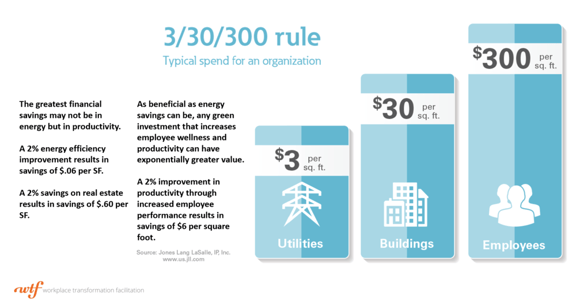When planned and designed correctly, Smart Buildings can optimize both building performance and occupant experience. Traditionally, these two sides of the stakeholder equation are diametrically opposed in the built environment. If an owner focused on improving building performance metrics like sustainability or energy efficiency, it often came at the expense of occupant comfort and experience. A focus on occupant experience, like allowing users to have more control over temperature settings in their space, would decrease building performance through increased operational costs.
Quantifying the value a Smart Building provides by optimizing occupant experience can be difficult. One of the most widely cited frameworks is JLL’s “3-30-300” rule, which illustrates a company’s average annual cost for utilities, rent, and payroll on a per square foot basis:

How can Smart Buildings improve productivity, and can companies rely on this improvement when considering Smart Building deployment? Owners often attempt to evaluate this on a technology-by-technology basis. For example, does the upgraded cost for LED lighting with adjustable color temperature have a quantifiable return? While this discussion has merit, owners looking to understand how Smart Buildings can improve employee productivity should focus on something different: agency.
Sense of agency refers to the feeling of controlling one’s actions and their consequences, the sense that “I am the one who is causing or generating an action.” A large body of research positively links an individual’s sense of agency or autonomy in the workplace with their output, productivity, and overall job satisfaction. For example, findings from a study published by Rebecca Johannsen and Paul Zak in 2020 indicated that “an increased perceived autonomy can significantly improve individual and group productivity.” Similarly, research published by Gensler found that knowledge workers who felt a sense of agency “were more likely to be satisfied with their jobs, performed better, and viewed their company as more innovative than competitors…”
As part of the Smart Building design process, owners should focus on whether their choices for building technologies and their integration will give its occupants a sense of agency.
There are several ways a Smart Building can facilitate agency:
Personalization- The technology of making experiences personalized is pervasive in our culture today. If you think about the last time you shopped online or used a video streaming platform, you will recognize how that experience was personalized to your history and preferences. Across industries, we see the demand and expectation for personalization in the built environment; investing in technologies that enable personalization will significantly increase the feeling of agency for a building’s occupants. Giving occupants control over their HVAC and lighting settings or applications that make recommendations on workspace locations based on their schedule for the day are all simple examples of ways that the right design and utilization of technology can deliver an engaging, personalized experience on or inside a property.
Flexibility – The freedom of choice and flexibility gives occupants an essential sense of control over their actions. Providing flexible workspaces that employees can choose based on their type of work that day – small collaboration rooms, comfy couches, or acoustic-controlled single spaces – is an example of how technology can empower occupants to make choices and recognize a sense of control. To execute this flexibility well, owners need to thoughtfully deploy sensors, successfully integrate disparate systems and leverage user-facing technology, and maintain an effective data intelligence strategy that ensures efficient space utilization and appropriate allocation of building resources.
Feedback – Providing feedback easily and efficiently on building operations or facility concerns is another way to improve the sense of agency for occupants in a space. However, it is equally important that your operations team can communicate in a bidirectional manner with those occupants, providing status reports on the issues that have been submitted and indicating when they’ve been resolved.
Transparency in Reporting – When planned, designed, and deployed correctly, a Smart Building provides a critical tool missing in most real estate assets today: the ability to communicate with transparency with building stakeholders. With the right utilization of data and an effective strategy for systems integration, a facility owner can use data analytics to demonstrate building performance and sustainability metrics and provide insight into how occupants can make choices to reduce a facility’s energy consumption. Providing occupants with a choice is not only engaging; it connects them with the operation of the building and their personal investment in making it more healthy and sustainable.
There are various ways the workplace, property owner, or employer can cultivate a sense of agency in the workplace. The role of the built environment as a contributor to this sense of agency is too often overlooked. Smart Buildings and their thoughtful utilization of technologies and integrated systems have the potential to facilitate a greater sense of agency for building occupants, increasing productivity and job satisfaction and helping owners recognize the financial benefit of their investment in Smart Building technology.
When planned and designed correctly, Smart Buildings can optimize both building performance and occupant experience. Traditionally, these two sides of the stakeholder equation are diametrically opposed in the built environment. If an owner focused on improving building performance metrics like sustainability or energy efficiency, it often came at the expense of occupant comfort and experience. A focus on occupant experience, like allowing users to have more control over temperature settings in their space, would decrease building performance through increased operational costs.